Introduction
Design & Appearance
{{section_header}}{{section.name}}{{/section_header}}
The Sony A57 follows in the tradition of the A57, feeling like someone took your typical DSLR and just compressed it slightly. The A57 is a little larger and heavier than its predecessor, giving it a more durable feel. It still comes in at under 1.5 pounds, so it's still a compact little DSLR. The grip has a less textured feel, but it's curved with an indentation for the index fingers, instead of one long smooth contour as on the A55. This gives a secure, plush feel to the A57, with the front dial facing at a more upward angle, so it hugs against the index finger when changing settings.
Other than that, the A57 doesn't dramatically change the layout from the A55. The rear button layout is practically identical to the previous model, though the rear plate stays relatively flat owing to the taller profile of the camera. This actually makes the buttons easier to press against, because they're nearer to the thumb than in the A55. In general we'd describe the A57 as comfortable to shoot with for an extended period of time, though it's not as compact as the A55.
Tour
{{section_header}}{{section.name}}{{/section_header}}




Menu
{{section_header}}{{section.name}}{{/section_header}}
The menu on the Sony A57 is arranged in tabs lined up horizontally along the top edge of the screen. These tabs include options for still shooting, video shooting, system settings, playback, memory card, custom, and clock settings. Each tab features multiple pages inside of it. The menu is clear and legible, with the default setting offering white text on a black background (we're not sure if this can be changed). It's extremely similar to the A55, though, so anyone upgrading or used to shooting with a slightly older Sony DSLR will feel right at home.
Ease of Use
{{section_header}}{{section.name}}{{/section_header}}
The A57 offers a great deal of features that are designed to aid the novice photographer, but there are so many of them it can get confusing trying to keep track of them all. The newest feature in the A57's usability arsenal is Sony's "auto portrait framing" mode. In this mode, the camera will detect faces and then automatically produce a cropped version of the shot that incorporates common framing techniques such as the rule of thirds. The cropped shot even retains the same resolution (though interpolated) using Sony's By Pixel Super Resolution feature. Fear not, the camera still retains your original version, but it's a mode designed to show you how to better frame your shot in the first place.
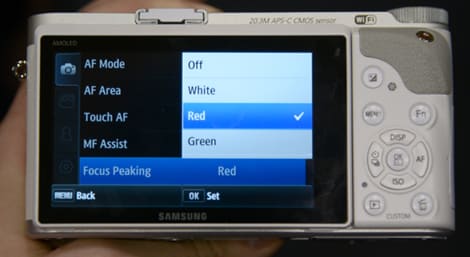

Size & Handling
{{section_header}}{{section.name}}{{/section_header}}
The A57 is slightly larger than the A55, with a wider and somewhat taller profile. Its button layout is practically identical, but the grip has undergone a serious overhaul, with the shape of the top plate also changing. The grip now is contoured to fit the hand, but also includes an indentation where the index and middle fingers can more naturally fall. The top plate is now curved more upward, especially near the front of the camera, with the front control dial now sloping at a more upward angle, allowing the index finger to freely change settings at a slightly more natural angle.
We are generally in favor of the changes Sony made to the A55's design (a camera we already enjoyed shooting with), but we wish they had tackled the button design and layout a little more. The rear control pad features a concave shape, curving inward to the center AF button. We like the fact that they kept the dedicated video record, exposure lock, and zoom buttons as-is, but feel a rear control dial with the ability to click cardinal directions would've aided menu navigation and control immensely.

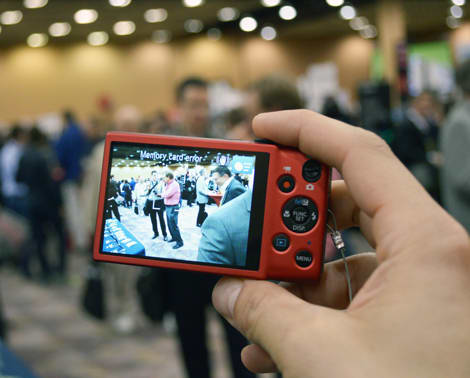
Modes Overview
{{section_header}}{{section.name}}{{/section_header}}
The Sony A57 features a full, physical mode dial on the top plate of the camera, beside the optical viewfinder. This dial includes 12 modes in total, with options for PASM shooting, video recording, 3D sweep panorama, 2D sweep panorama, iAUTO, auto with flash disabled, Superior Auto+, continuous advance priority AE, and scene modes. There are eight scene modes, including several that stitch multiple frames together to form one image that better copes with tough conditions.

Auto Mode
{{section_header}}{{section.name}}{{/section_header}}
The two main automatic modes on the Sony Alpha A57 are iAuto and Superior Auto+. iAuto is your typical Sony automatic mode, which simplifies the control of the camera while setting certain ranges for ISO, shutter speed, and video recording shutter speed in order to produce better images.
Superior Auto+ is a relatively new addition from Sony that has appeared on a few of their point-and-shoot cameras. The mode combines scene recognition technology along with multi-shot capability to produce images. This goes slightly beyond your typical auto scene recognition system, but the effect is the same. This is a good mode for novices who are shooting in conditions that are rapidly changing, such as moving from indoors to outdoors, and don't want to futz about in a menu they aren't totally confident with yet.
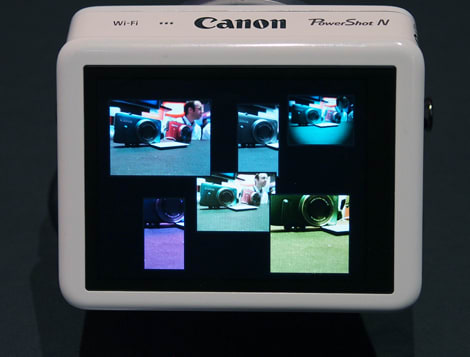
Movie Mode
{{section_header}}{{section.name}}{{/section_header}}
The Sony A57 features full 1080/60p video recording, with the ability to utilize phase detection autofocus while taking a video. This results in a somewhat smooth transition between shots, though if you're planning on shooting anything for professional use manually pulling focus will still be your best bet. In addition, the Sony A57 also sports 30p and 24p shots, great for anyone looking for a more filmic look to their action videos.
Video is recorded on the Sony A57 in AVCHD / MP4 with H.264 compression. Video has a maximum bitrate of 28Mbps when shooting in 60p, so it's more than enough data for a DVD or home video, but you'll likely want to look elsewhere for professional videography. The camera also features a built-in microphone, with a stereo microphone jack to be found on the left side of the camera behind a small rubber flap.
Drive/Burst Mode
{{section_header}}{{section.name}}{{/section_header}}
The Sony A57 is, quite simply, an absolute speed demon. While for most camera companies 10fps is the province of the most expensive, highest-quality DSLRs only, Sony accomplishes this with a regularity that is downright frightening. The SLT design of the Alpha A57 uses a pellicle mirror that, unlike a traditional DSLR, doesn't need to flap up and down between shots. The result is 10 continuous frames per second, with autofocus continually adapting with each shot. Most cameras that can shoot faster than 4fps do so with focus locked in at the first shot, so the A57 simply laps the competition in this regard.
The A57 can even go faster than that, with the camera's Tele-Zoom High Speed Shooting mode. In this mode, the camera only uses the center 2/3rds of the image sensor, recording 8.4-megapixel images at a 12fps clip. By using the smaller section of the sensor, this also creates a 1.4x zoom, at the expense of increased resolution.
Playback Mode
{{section_header}}{{section.name}}{{/section_header}}
The Sony Alpha A57 features a pretty basic set of playback functionality. Once a shot is captured you have the ability to zoom in on a single file, zoom out to view several files on the screen at once, or see an overview of information about a file. You can access playback by pressing the dedicated button on the back of the camera just below the rear control pad. You can even use the electronic viewfinder to review files up close, with all the same functionality as you would have looking at them on the rear screen.
Picture Quality & Size Options
{{section_header}}{{section.name}}{{/section_header}}
Inside the Sony Alpha A57 sits an EXMOR 16-megapixel CMOS image sensor. The camera offers the abilities to shoot in 16:9 or 3:2 aspect ratios, in addition to the panoramic images taken in Sony's Sweep Panorama mode. In standard shooting modes, you can record images in JPEG, RAW, or RAW+JPEG, with size options that include 16, 8.4, and 4 megapixels for 3:2, and 14, 7.1, and 3.4 megapixels in 16:9.
Focus
{{section_header}}{{section.name}}{{/section_header}}
The Sony Alpha A57 features a 15-point phase detection autofocus system, with 3 cross-type AF points. Because of the camera's translucent pellicle mirror technology, the camera can utilize phase-detection autofocus even while shooting in live view, recording video, or using the electronic viewfinder. The camera has three autofocus modes (single, continuous, and automatic) with three AF area settings (wide, spot, and local AF). In addition, subject tracking autofocus is available, letting you specify a moving subject (including faces) and track them through a frame. This works somewhat well, but it struggled significantly with backlit subjects, as the tracking focus gets stuck on any hard edge where contrast is high.
Having the electronic viewfinder was a bit of a mixed bag on the A57. On the one hand, the abilities to use peaking to highlight in-focus areas made manually focusing infinitely easier, including while recording video. On the other, the electronic viewfinder's resolution does not display subject detail as finely as an optical viewfinder, so for still images you may miss focus and not know until later on.
Exposure & Metering
{{section_header}}{{section.name}}{{/section_header}}
The A57 makes use of a 1200-zone metering system, as it's able to utilize the full image sensor for metering rather than a dedicated sensor elsewhere in the camera. We found the metering to be pretty spot on, especially because the camera uses an electronic viewfinder. This lets you see not only all of your current shooting settings, but the relative effect of those settings on image brightness right in the viewfinder. The camera allows you to automatically meter with the entire frame, a center-weighted average, or a spot reading.
ISO
{{section_header}}{{section.name}}{{/section_header}}
The 16-megapixel EXMOR sensor on the Sony A57 has an ISO range of 100-16000, though that can be pushed to 25600 with the camera's multi-frame noise reduction setting. When shooting in the iAUTO mode, this is restricted to a range of 100-3200, limiting your options somewhat. If you have to push ISO to one of the higher settings, the camera features long exposure noise reduction, as well as high ISO noise reduction, with high, normal, and low options.
White Balance
{{section_header}}{{section.name}}{{/section_header}}
The A57 features a pretty typical setup for white balance, with presets for daylight, shade, cloudy, incandescent, fluorescent, warm white, cool white, day white, flash, as well as automatic, custom, and direct kelvin entry settings. The camera has a dedicated white balance button on the right side of the rear control pad, labeled with a large "WB" for easy access. Custom white balance is pretty easy to set, as the camera's constant use of live view shooting lets you hit the button, and point the center of the frame at a white object, capturing a white balance reading.
Image Stabilization
{{section_header}}{{section.name}}{{/section_header}}
Like Sony's other Alpha interchangeable lens cameras (not their NEX line), the A57 features image stabilization built right into the body. This means that the camera will be able to stabilize and correct for camera shake with any lens that is attached to the camera.
Picture Effects
{{section_header}}{{section.name}}{{/section_header}}
The Sony A57 includes 11 types of picture effects, with 15 variations in total. These include posterization (color and B&W), pop color, retro photo, partial color (R, G, B, or Y), with high contrast monochrome, toy camera, soft high-key, soft focus, HDR painting, rich-tone monochrome, and miniature modes. We found the miniature mode to be the most fun, with the ability to set your area of focus horizontally or vertically, and in either the top, middle, or bottom third of the frame.
Lens Mount & Sensor
{{section_header}}{{section.name}}{{/section_header}}
The Sony A57 uses the Alpha mount for interchangeable lenses, giving it access to a number of currently-produced Sony lenses, third party lenses, as well as several older Konica Minolta lenses. The Sony lens family is almost criminally underrated, with some excellent large aperture prime lenses, especially their excellent 35mm f/1.4 lens. While some of their midrange zooms struggle and many lower-end lenses feature plastic lens mounts, the Sony lens family can match Nikon, Canon, and Pentax at most common focal lengths for a camera such as this.
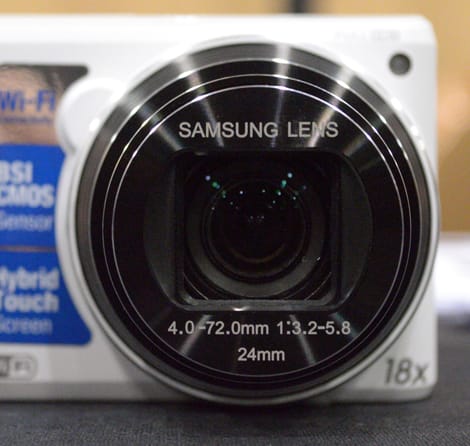

LCD & Viewfinder
{{section_header}}{{section.name}}{{/section_header}}
The A57 includes a rear 3-inch, 921k-dot display that swivels away from the body. The hinge is located at the bottom of the LCD, with the ability to face downward, upward, and even toward the subject that you're shooting at. The LCD can also rotate to the right nearly 180 degrees, giving you a way to see the LCD at nearly all times. The one downside to this hinge design is that with most tripods you won't be able to face the screen forward or get it far away from the body, limiting its usefulness for self-portraits and in some situations for video.

The viewfinder on the A57 sets the camera apart from many of its competitors, as it's an electronic double of the rear display. With their pellicle mirror technology only blocking a small portion of the light coming into the camera, there's no ability to use an optical finder the way a traditional DSLR might. Instead, the camera utilizes a small 0.46'', 1.440M pixel resolution display with a 1.04x magnification. It's not as accurate or pleasant as an optical viewfinder, but it presents some advantages. Namely, you can see relative brightness, shooting information, and images in playback on the viewfinder. Most crucially, you can use manual focus with the camera's peaking functionality, letting you easily manually focus in stills and video while just using the viewfinder.

Flash
{{section_header}}{{section.name}}{{/section_header}}
The A57 features a built-in flash with a guide number of 10 meters at ISO 100. That puts it among the more powerful basic built-in flashes in this class of DSLR, though it takes a full three seconds to recycle and fire again. The flash pops up from the body and is located just above the electronic viewfinder housing. In addition, the camera has a dedicated hot shoe for attaching external flashes and strobes. The flash can be controlled from inside the camera's menu, with options for fill flash, slow sync, red-eye reduction, rear sync, hi-speed sync, or wireless control. The flash can only sync with the shutter at speeds of 1/160th of a second and slower, however.

Jacks, Ports & Plugs
{{section_header}}{{section.name}}{{/section_header}}
The left side of the Sony Alpha A57 features a number of input/output ports behind several rubber ports. The camera includes the typical mini-HDMI and mini-USB 2.0 ports. Also included are a remote sync terminal, DC power slot, and 3.5mm stereo microphone input, each behind their own individual ports.
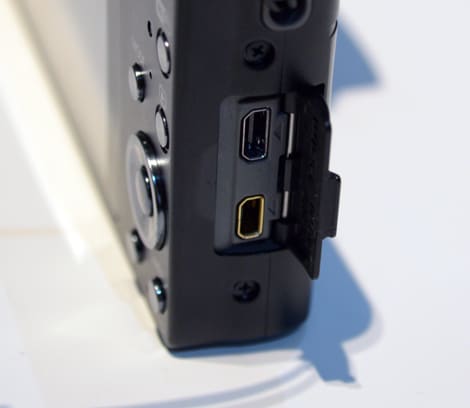
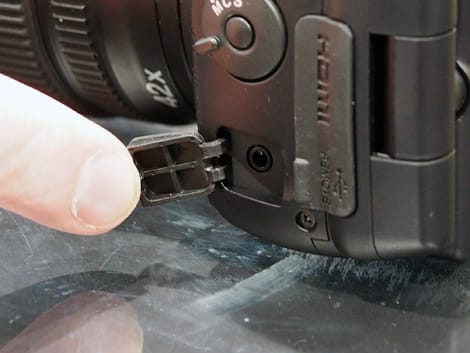
Battery
{{section_header}}{{section.name}}{{/section_header}}
The Sony A57 draws power from a proprietary lithium-ion battery, model number NP-FM500H. It's the same battery that the other current crop of Sony DSLRs use, including the new Alpha A77 and A65 models. The battery has a listed capacity of 1650mAh, which translates to a CIPA rating of 590 shots, or 550 shots per charge when using the electronic viewfinder. The battery slots into a dedicated compartment on the bottom of the camera right in the grip.

Memory
{{section_header}}{{section.name}}{{/section_header}}
The Sony Alpha A57 uses SD/SDHC/SDXC along with MemoryStick PRO Duo and PRO HG-Duo cards. Memory cards also have a dedicated slot on the right side of the body, with the plastic cover sliding out and away from the body. By positioning the memory card slot on the right side of the body, there's little issue with tripod designs getting in the way, letting you switch cards in and out with ease. That and the articulated LCD and the DC power port allow for tripod and studio shooters to use the camera without having to detach it from the tripod plate.

Conclusion
The Sony Alpha SLT-A57 is a modest upgrade over last year's A55, with a slightly redesigned body, improved sensor readout, additional usability features, and some intriguing control and processing options designed to help novices get more from their camera.
The main additions to the A57 are support for AVCHD 1080/60p video recording, 12fps continuous shooting (10fps at full resolution, but with continuous autofocus), Sony's Superior Auto+ shooting mode, and a new auto portrait framing mode. The additions are welcome, and add to a host of on-camera modes and tools designed to aid beginner shooters.
In our time with the camera, though, we were seriously impressed by the A57's sheer speed. It's something we've come to expect from Sony's line of SLT interchangeable lens cameras, but you never really get tired of hearing that shutter click more than 10 times every second. That the camera also continuously focuses during shooting (with moderate success) only enhances the feat.
To put that into perspective, the only full-size DSLRs from Canon and Nikon that shoot that fast cost north of $6000. Those cameras obviously come with other benefits to justify their price, but if it's speed you're after, the A57 at under $1000 looks like a bargain.
That speed does come with its own price, of course. The technology that allows for it rules out the use of an optical viewfinder, so you have to look at a tiny electronic viewfinder while shooting. The EVF can do in-finder playback and manual focus peaking, but optical viewfinders are still king in this regard. We also felt that the back of the camera could've done with a redesign, with the concave rear control pad feeling a little chintzy compared to the control dials seen on some competing cameras.
Still, any camera that can shoot 10 full resolution frames per second for under $1000 has to give us pause. On top of that, the improvements to handling haven't gone unnoticed, with the A57 more pleasant to shoot with than last year's A55. Though our time with the camera was short, we'll have a full performance breakdown as soon as we get a production A57 into our labs to see just how it stacks up against the competition. If it's got power to match that speed then the A57 might give our 2011 camera of the year, the Nikon D5100, a real run for its money.
{{product.vanity}}
Sample Photos
{{section_header}}{{section.name}}{{/section_header}}
Specs
{{manufacturer_specs_table}}
Meet the tester
TJ is the former Director of Content Development at Reviewed. He is a Massachusetts native and has covered electronics, cameras, TVs, smartphones, parenting, and more for Reviewed. He is from the self-styled "Cranberry Capitol of the World," which is, in fact, a real thing.
Checking our work.
Our team is here to help you buy the best stuff and love what you own. Our writers, editors, and experts obsess over the products we cover to make sure you're confident and satisfied. Have a different opinion about something we recommend? Email us and we'll compare notes.
Shoot us an email